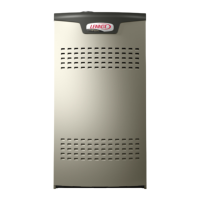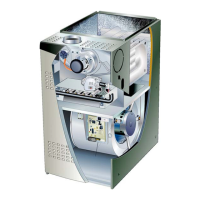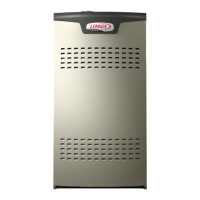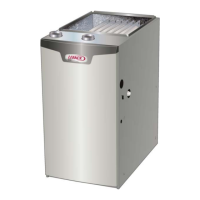Page 12
HORIZONTAL UNIT
SUPPLY
AIR
SUPPLY
AIR
Install self tapping screws
to seal any potential air
leaks
UPFLOW UNIT
FIGURE 14
Return Air Plenum
NOTE - Return air must not be drawn from a roomwhere
this furnace, or any other gas-fueled appliance (i.e., water
heater), or carbon monoxide producing device (i.e., wood
replace) is installed.
When return air is drawn from a room, a negative pressure
is created in the room. If a gas appliance is operating in
a room with negative pressure, the ue products can be
pulled back down the vent pipe and into the room. This
reverse ow of the ue gas may result in incomplete com-
bustion and the formation of carbon monoxide gas. This
toxic gas might then be distributed throughout the house
by the furnace duct system.
In upow applications, the return air can be brought in
through the bottom or either side of the furnace. If a fur-
nace with bottom return air is installed on a platform, make
an airtight seal between the bottom of the furnace and
the platform to ensure that the unit operates properly and
safely. Use berglass sealing strips, caulking, or equiva-
lent sealing method between the plenum and the furnace
cabinet to ensure a tight seal. If a lter is installed, size the
return air duct to t the lter frame.
Venting
A 4-inch diameter ue transition is factory-installed on the
combustion air inducer outlet of all models
The EL180UHNE series units are classied as fan-assist-
ed Category I furnaces when vertically vented according
to the latest edition of National Fuel Gas Code (NFPA 54
/ ANSI Z223.1) in the USA. A fan-assisted Category I fur-
nace is an appliance equipped with an integral mechan-
ical means to either draw or force combustion products
through the combustion chamber and/or heat exchanger.
The EL180UHNE is not approved for use with horizontal
venting.
NOTE - Use these instructions as a guide. They do not
supersede local codes. This furnace must be vented ac-
cording to all local codes these installation instructions,
and theprovided venting tables in these instructions
The venting tables in this manual were extracted from the
National Fuel Gas Code (NFPA 54 / ANSI Z223.1) and are
provided as a guide for proper vent installation. Proper
application, termination, construction and location of vents
must conform to local codes having jurisdiction. In the ab-
sence of local codes, the NFGC serves as the dening
document.
Use self-drilling sheet metal screws or a mechanical fas-
tener to rmly secure the vent pipe to the round collar of
the ue transition. If self-drilling screws are used to attach
the vent pipe, it is recommended that three be used. Drive
one self-drilling screw through the front and one through
each side of the vent pipe and collar. See FIGURE 15.
Install the rst vent connector elbow at a minimum of six
inches (152 mm) from the furnace vent outlet. See gure
15.
Venting Using a Masonry Chimney
The following additional requirements apply when a lined
masonry chimney is used to vent this furnace. Masonry
chimneys used to vent Category I central furnaces must
be either tile-lined or lined with a listed metal lining sys-
tem or dedicated gas vent. Unlined masonry chimneys are
prohibited. See FIGURE 16 and FIGURE 17 for common
venting.
A chimney with one or more sides exposed to the outside
of the structure is considered to be an exterior chimney.
An exterior masonry chimney that is not tile-lined must be
lined with B1 vent or a listed insulated exible metal vent.
An exterior tile-lined chimney that is sealed and capped
may be lined with a listed uninsulated exible metal vent.
If the existing chimney will not accommodate a listed met-
al liner, either the chimney must be rebuilt to accommo-
date one of these liners or an alternate approved venting
method must be found.
Insulation for the exible vent pipe must be an encapsu-
lated berglass sleeve recommended by the exible vent
pipe manufacturer. See FIGURE 16. Refer to the tables
and the venting information contained in these instruc-
tions to properly size and install the venting system.

